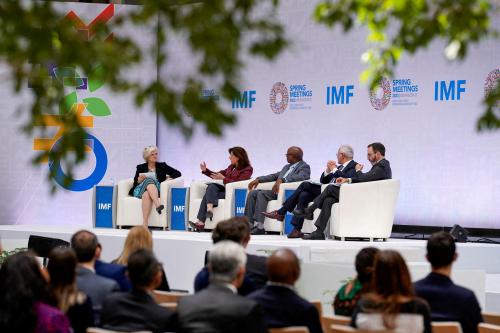The larger “leaders table” of the G20+ should be welcomed. The emerging country leaders that will be sitting around the table in London will be in a (slight) majority. The G20+ may not be ideal, but it brings together the rich old economies with the major emerging market countries – the latter now account for the vast majority of the world’s population and one-half or one-third of world GDP, depending on whether measured at PPP or market prices. The presence of regional representatives from Asia and Africa will give even the less developed countries some voice at the London meeting.
Developing countries need supportive global policy action for systemic economic reasons. Few individually have systemic importance in terms of aggregate world demand or financial assets (China does, of course). In the aggregate, however, an economic collapse in large parts of Eastern Europe, Latin America, and Asia would impart another major deflationary impulse to the world economy.
The developing countries also require support for political and equity reasons. Widespread economic distress due to a crisis not of their own making would have serious political consequences – justified anger could lead to massive political instability. And elementary justice demands that the most vulnerable be protected from a storm coming from the strongest advanced economies.
Acting in developing countries’ interests
Despite the constraints of a preparatory process still dominated by officials from the rich countries, with their more plentiful resources and staffing, the presence of the developing countries should promote action on three fronts.
First, there is the need for liquidity of the kind that the advanced economies have provided to their financial and industrial sectors to prevent a collapse due to the credit crunch. Many emerging markets now face threatening roll-over problems, especially those with large current account deficits and largely foreign-owned banking systems. For 2009 and 2010, a minimum of $500 billion will be needed, at least in the form of potential availability of liquidity by these countries. Only a small part has been provided so far. This support must be relatively easy to access, just as it has been in the advanced countries. Putting this potential liquidity in place is likely to diminish the amount that actually will be used. Moves by the IMF to transform its Short Term Liquidity Facility into a credit line allowing wider access are welcome, but they can only become operational if sufficient resources are made available.
Moves by Japan and the US to offer a $100 billion loan to the IMF are welcome but not sufficient. The problem is that some key surplus countries such as China will rightly insist that governance reforms must proceed before they make large resources available to the IMF. If their quotas are small, why should they shoulder a big part of the financing burden? But the problem is not just one of resource availability. Developing countries as a group need more legitimate governance at the IMF to overcome the stigma and political rejection that prevent it from playing a major global role. And access conditions must not be made too difficult in what is an emergency. So a more vigorous movement towards governance reform, as will be proposed by a committee looking into these matters headed by Trevor Manuel of South Africa, is actually a condition for more effective financing, not a luxury that can be put off much longer. In the meantime, regional arrangements with special governance mechanisms could supplement central IMF action.
The second set of problems relates to fiscal policies in developing countries. One size cannot fit all, and current account deficits as well as debt levels constrain fiscal space in many cases. Nonetheless, optimal policies in most countries will have to combine short-term discretionary fiscal stimulus – automatic stabilisers are absent in most developing countries – with longer-term reforms strengthening the public sectors’ balance sheet. Such policies cannot be worked out in a rush, and so long as the principle is agreed upon, details of how this will be done should not hold up the access to liquidity discussed above. Greatly stepped up longer-term lending from the World Bank and the regional development banks can accompany these longer-term reforms and contribute to creating fiscal space. A key part of this longer-term lending should allow much needed infrastructure investment to proceed, crowding-in private investment. That investment should also help developing countries launch action plans that will reduce carbon emissions and make a global climate deal feasible. Lending by the World Bank and the development banks should compensate for the steep decline in private funding for long-term investment that we have started to witness.
Finally there is the urgent need to protect the most vulnerable. The poorest countries are beginning to face the devastating impact of steep declines in export revenues and remittances. Some face a collapse in tourism. Unemployment is rising rapidly from already high levels, food prices are below their 2008 peaks but higher than in the preceding decade, and social safety nets are extremely weak. Just when it appeared as if per capita incomes would be able to rise at 2% to 3% a year after decades of stagnation, there is now the danger of per capita growth rates turning negative in the poorest countries. The prospects for despair, anger, violence and spreading state failure are real, and need to be countered. While major architectural reforms are needed in the way aid is given so that its long-term effectiveness can increase, this is a time for defining the coordinated actions and procedures to deliver existing official development assistance commitments and strengthen the humanitarian and safety net components, including what is delivered through the UN system. The OECD Development Assistance Committee numbers show recent annual flows of official development assistance in the $100 to $110 billion range, below what had been firmly promised. The London summit should not only commit to some increase in these amounts for the next two years, but should describe the concrete steps through which commitments will be delivered. Part of it should be achieved by an increase in the share of direct budget support, allowing more rapid disbursement at a time of great urgency.
Opportunity in London
Announcing aggregate numbers is always the easy part. Translating them into policies and actions is what counts. The group of leaders assembling in London has a fantastic opportunity to steer the world onto the path of recovery by launching such measures with truly global reach.



Commentary
Op-edThe Developing Countries and the G-20
March 20, 2009